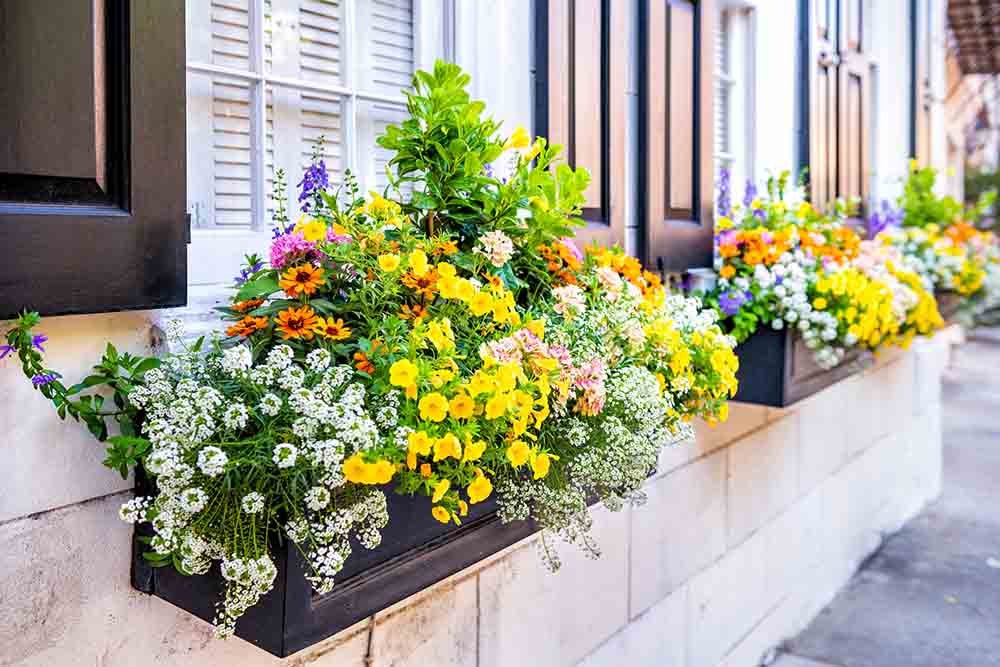Window box gardening offers a distinctive way to bring nature closer to home. Whether you’re in a bustling city apartment or a suburban home, these little gardens can transform your view. They’re not just for spring and summer; with the right approach, they can provide year-round beauty. If you’re intrigued, here are the tips and tricks on how to maximize your window box garden:
Table of Contents
Select Plants Wisely
Choosing the right plants can make or break your window box garden. If you’re considering adding some greenery, consider trailing plants for window boxes to enhance the beauty of your exterior. It’s essential to consider not only the aesthetic appeal but also the plant’s needs and how they align with the environment you can provide. Here are some factors to keep in mind:
- Sunlight: North-facing windows receive less sunlight, making them suitable for shade-loving plants like ferns or impatiens. In contrast, south or west-facing windows are bathed in sunlight, perfect for sun-loving plants like marigolds or lavender.
- Growth Habit: Consider how plants grow. Ensure there’s a balance in your window box. For example, complement trailing plants like ivy or petunias with upright ones like snapdragons or daisies.
The goal is to create a harmonious display that’s also sustainable for the plants you prefer.
Use The Right Soil
Good soil equals happy plants. Instead of using an ordinary one, opt for a high-quality potting mix specifically formulated for container plants. Such soil is lighter, promotes better aeration essential for root health, ensures optimal drainage, and provides the nutrients plants require. Moreover, the right soil can help control weeds.
Pick The Ideal Box
The choice of window box is crucial for your mini garden’s success. Ensure your window box is robust and has ample drainage holes to prevent root rot. The material of your box can also affect plant health:
- Wooden Boxes: These provide a timeless appearance and are excellent for moisture retention. However, they should be treated to avoid rot and decay.
- Metal Boxes: They can heat up quickly in the sun, which might affect the roots. However, they’re long-lasting and can add a modern touch to your window.
- Resin Or Plastic Boxes: They are lightweight and often budget-friendly, resist rot, and are available in various styles. Ensure they have efficient drainage.
While aesthetics matter, the box’s functionality is paramount. It should support the growth of your plants and complement your home’s style.
Water Regularly But Wisely
Overwatering is a common mistake. Check the soil’s moisture before watering. If it’s dry an inch below the surface, it’s time to water. In hotter months, your plants might require more frequent watering. Yet, continuously waterlogged soil should be avoided.
Remember, while plants need water, consistently damp conditions can lead to diseases like root rot. Striking the right balance is vital: provide necessary hydration without drowning them.

Fertilize For Growth
Plants in window boxes deplete nutrients faster than those in the ground. Use a slow-release fertilizer or liquid feed every couple of weeks. This keeps your plants vibrant and healthy.
Moreover, the confined space of a window box means roots can’t stretch out in search of nutrients, making regular fertilization crucial. Selecting an appropriate fertilizer based on your plants’ requirements can influence their growth and bloom quality.
Protect From Extreme Weather
Window box plants are more vulnerable to weather extremes than ground-planted ones. In winter, insulate your window box or move it indoors to protect plants from frost and icy conditions.
For hot summer days, think about using a shade cloth or relocating the box to a shadier spot during the hottest hours. While plants are resilient, shielding them from extreme temperatures can greatly prolong their life and preserve their attractiveness.
Stay Vigilant Against Pests
Pests can quickly turn a thriving window box into a withered display. Inspecting your plants regularly is essential. Here’s what to keep in mind:
- Early Detection: The sooner you spot pests, the easier they are to manage. Check the undersides of leaves and stems, as many pests prefer these areas.
- Regular Cleaning: Remove fallen leaves or debris from your window box. Doing so eliminates hiding spots for pests and prevents fungal diseases.
Keep an eye out for common pests like aphids or spider mites. If you spot any, treat them immediately with natural remedies or insecticidal soap. A healthy garden is a pest-free garden.
Mix And Match
Combine different plants for texture and color. Think about height, color, and blooming times. For instance, pairing tall ornamental grasses with cascading vines can yield a dynamic visual impact, potentially enhancing your home’s curb appeal.
Similarly, contrasting vibrant blooms with subdued, leafy greens can make each plant stand out more distinctly. A mix of perennial and annual plants can keep your window box lively throughout the year.
Conclusion
Window box gardening isn’t just decorative. It’s a way to connect with nature, right from the comfort of your home. With proper care and attention, your window box can be a year-round source of beauty and inspiration. So, roll up your sleeves, get planting, and watch your mini garden thrive.










